-
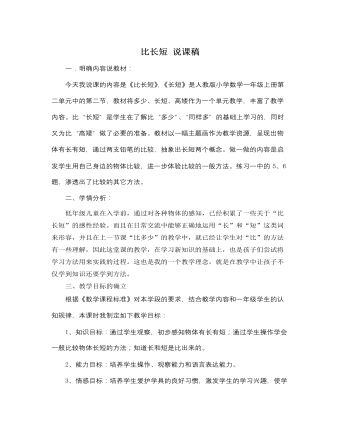
人教版新课标小学数学一年级上册比长短 说课稿
通过游戏活动,让学生体验比长短的一般方法,进一步加深学生对长短概念的认识。可以引导学生用自己身边的物品进行比较,也可以提示学生:比一比每步多长,谁跳得远等等。教师参与到学生的游戏中去,与学生一起活动,对有创新的学生要给予表扬和肯定。学生结组活动,用日常生活中的物品或自己身体的某个部位比长短,使学生初步感悟到生活中处处有数学。 第四环节,知识消费,提高兴趣 出示教科书12页6题,引发思考:你看蛇和鳄鱼也在为谁长谁短争执起来。请小朋友作裁判好吗? 安排一组练习,可进一步巩固所学知识,说出比长短的多种方法,发散学生的思维,培养学生的想象力和创新意识。 六、教学反思:本节课,我把教学内容在知识点不变的基础上,以发挥学生主动性,联系学生生活实际,遵照学生年龄特点,激发兴趣为主。
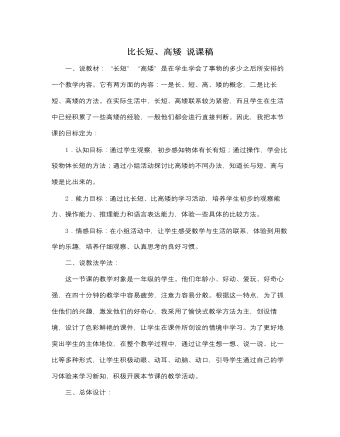
人教版新课标小学数学一年级上册比长短、高矮 说课稿
第一步骤是:游戏引入课一开始,我先出示2支铅笔,用手捏住一端,这样让学生产生一个错觉,再放开手,让学生重新进行判断,从而得出比较2个物体的长短要一端对齐的方法。从游戏引入,能很好地激发学生的好奇心,同时又利用学生的已有经验,由学生轻松得出比较长短的方法,为下面的活动做好了知识铺垫,既有趣,又有效。第二步骤是:比长短活动有了刚才比的方法的铺垫,再让学生找找自己想比长短的东西,然后进行自由比较。在这里,主要要放手让学生发挥自主性,但由于学生年龄太小,这里教师要加强引导,所以在让学生自己比之前,我让学生先说说想到了可以比什么。在学生自己动手的时候,我也深入其中,加强指导。在反馈时,还让学生演示一下,一方面要让学生体验到交流的成就感,另一方面也是培养其他学生认真倾听的习惯。
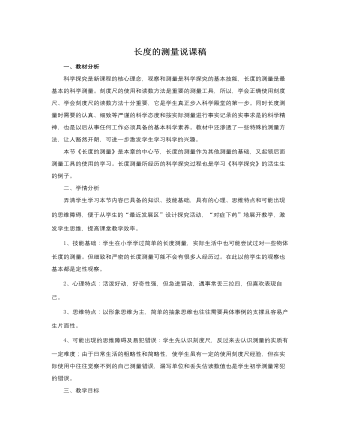
人教版新课标小学数学三年级上册长度的测量说课稿
长度测量是其它测量的基础,而且学生虽然接触过有关长度的测量,但技能还很不稳定,更是不规范。所以本内容强调教师指导作用,教师及时纠正学生的错误操作,并组织讨论错误测量引起的测量值偏差,测量结果的正误。教学定位应力求实验操作规范,观察认真细致,给学生以示范作用。5、建立一个人体尺度意义提问:如果我们手边没有刻度尺,又需要粗略地知道物体(如科学课本、课桌、教室……)的长度时,你有什么办法吗?(提问,给出了建立人体尺度的目的)(可能回答:用人体的指距、跨步距离……进行粗测)学生分组实验:利用人体的指距、跨步距离……粗测课桌的长和宽、教室的长和宽,并与用刻度尺测量的结果进行对照。以上做法相当于学生在自己身上设置了一把尺子,这把尺子与身体的其他“尺子”联系在一起,还可以做出其他许多的估计,有利于因地制宜培养学生的估测能力。
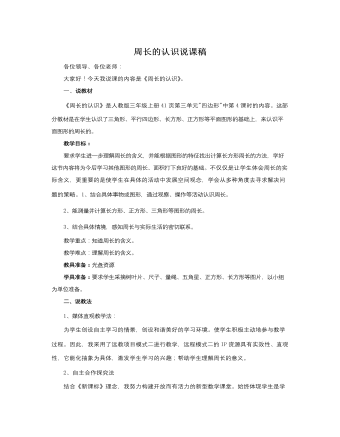
人教版新课标小学数学三年级上册周长的认识说课稿
(四)联系实际,应用周长在学生有了感性认识的基础上进一步理解周长的意义,并学会用周长的知识去解决一些简单的实际问题。播放光盘中的动画:有两只小蜗牛赛跑,它们都觉得自己跑的路线长,你有什么办法帮助他们解决这个问题吗?让学生想办法帮小蜗牛它们解决这个问题。光盘资源中的动画激发学生的学习兴趣,培养学生运用所知识解决问题的能力。这个环节的设计主要目的是让学生感受数学与生活的联系,增强学习的趣味性,感受数学在现实世界中有着广泛的应用。(五)总结全课同学们,这节课,我们认识了什么?你有什么收获吗?(我们从认识边线进而认识了周长,从探索不同形状的物体周长的测量方法,到尝试去计算各种图形的周长。在我们生活中,每个物体的表面都有它们各自的周长。周长的知识在生活中的应用还是很广泛的。
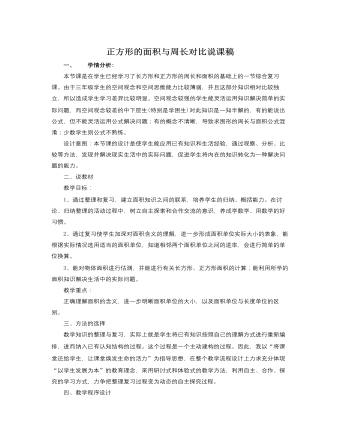
人教版新课标小学数学三年级下册正方形的面积与周长对比说课稿
1.估计一下教室地面的大小,并说说你是怎样估计的?如果知道教室的长为8米,宽为6米,请问它的面积是多少?如果要在教室的天花板一周围上装饰线条,需要多少米线条?2.小刚房间的一面墙壁长6米,宽3米,墙上有一扇窗面积是3平方米,现在要粉刷这面墙壁,要粉刷的面积是多少?3.一辆洒水车每分行驶60米,洒水的宽度是8米,洒水车直行9分,被洒水的地面是多少平方米?4.一张长方形的纸,长9厘米,宽4厘米,剪下一个最大的正方形后,剩下纸片的面积是多少平方厘米?5.小明用36厘米长的铁丝围成一个正方形,这个正方形的面积是多少平方厘米?6.有两个大小一样的长方形,长18厘米,宽9厘米,拼成一个正方形,它的周长是多少?拼成一个长方形,它的周长是多少?拼成的两个图形面积有什么关系?是多少?
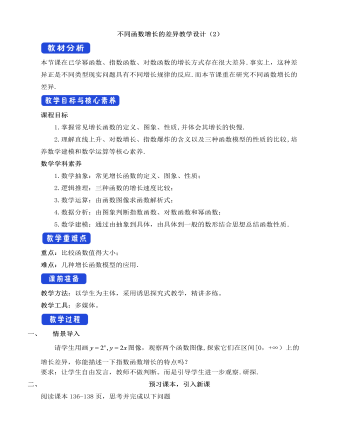
人教A版高中数学必修一不同函数增长的差异教学设计(2)
本节课在已学幂函数、指数函数、对数函数的增长方式存在很大差异.事实上,这种差异正是不同类型现实问题具有不同增长规律的反应.而本节课重在研究不同函数增长的差异.课程目标1.掌握常见增长函数的定义、图象、性质,并体会其增长的快慢.2.理解直线上升、对数增长、指数爆炸的含义以及三种函数模型的性质的比较,培养数学建模和数学运算等核心素养.数学学科素养1.数学抽象:常见增长函数的定义、图象、性质;2.逻辑推理:三种函数的增长速度比较;3.数学运算:由函数图像求函数解析式;4.数据分析:由图象判断指数函数、对数函数和幂函数;5.数学建模:通过由抽象到具体,由具体到一般的数形结合思想总结函数性质.重点:比较函数值得大小;难点:几种增长函数模型的应用.教学方法:以学生为主体,采用诱思探究式教学,精讲多练。教学工具:多媒体。
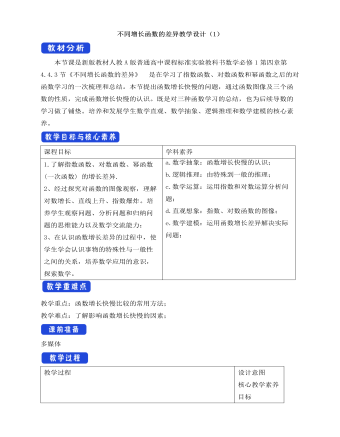
人教A版高中数学必修一不同增长函数的差异教学设计(1)
本节课是新版教材人教A版普通高中课程标准实验教科书数学必修1第四章第4.4.3节《不同增长函数的差异》 是在学习了指数函数、对数函数和幂函数之后的对函数学习的一次梳理和总结。本节提出函数增长快慢的问题,通过函数图像及三个函数的性质,完成函数增长快慢的认识。既是对三种函数学习的总结,也为后续导数的学习做了铺垫。培养和发展学生数学直观、数学抽象、逻辑推理和数学建模的核心素养。1.了解指数函数、对数函数、幂函数 (一次函数) 的增长差异.2、经过探究对函数的图像观察,理解对数增长、直线上升、指数爆炸。培养学生观察问题、分析问题和归纳问题的思维能力以及数学交流能力;3、在认识函数增长差异的过程中,使学生学会认识事物的特殊性与一般性之间的关系,培养数学应用的意识,探索数学。 a.数学抽象:函数增长快慢的认识;b.逻辑推理:由特殊到一般的推理;
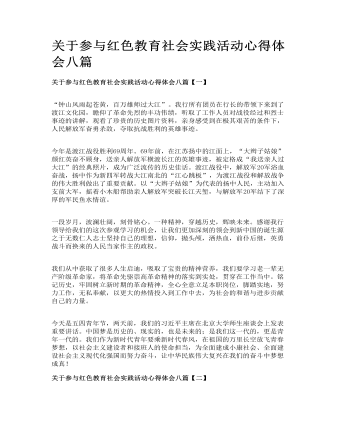
关于参与红色教育社会实践活动心得体会八篇
一段岁月,波澜壮阔,刻骨铭心。一种精神,穿越历史,辉映未来。感谢我行领导给我们的这次参观学习的机会,让我们更加深刻的领会到新中国的诞生源之于无数仁人志士坚持自己的理想,信仰,抛头颅,洒热血,前仆后继,英勇战斗而换来的人民当家作主的政权。 我们从中获取了很多人生启迪,吸取了宝贵的精神营养,我们要学习老一辈无产阶级革命家,将革命先驱崇高革命精神的落实到实处,贯穿在工作当中。铭记历史,牢固树立新时期的革命精神,全心全意立足本职岗位,脚踏实地,努力工作,无私奉献,以更大的热情投入到工作中去,为社会的和谐与进步贡献自己的力量。

新人教版高中英语必修3Unit 3 Diverse Cultures-Discovering Useful Structure教学设计
Step 4 PracticeRead the conversation. Find out which words have been left out.Justin: Linlin, I’m going to Guizhou Province next month. I’m super excited! Any recommendations for places to visit?Linlin: Wow, cool! Guizhou is a province with a lot of cultural diversity. Places to visit...well, definitely the Huangguoshu Waterfall first.Justin: What’s special about the waterfall?Linlin: Well, have you ever heard of the Chinese novel Journey to the West ?Justin: Yes, I have. Why ?Linlin: In the back of the waterfall, you will find a cave, which is the home of the Monkey King.Justin: Really? Cool! I’ll definitely check it out.Linlin:And I strongly recommend the ethnic minority villages. You’ll find Chinese culture is much more diverse than you thought.Justin:Sounds great, thanks.Answers:Justin: Linlin, I’m going to Guizhou Province next month. I’m super excited! Do you have any recommendations for places to visit?Linlin: Wow, that’s cool! Guizhou is a province with a lot of cultural diversity. What are some places to visit in Guizhou ? Well, definitely the Huangguoshu Waterfall is the first place to visit in Guizhou Province.Justin: What’s special about the waterfall?Linlin: Well, have you ever heard of the Chinese novel Journey to the West ?Justin: Yes, I have heard of the Chinese novel Journey to the West . Why do you ask if I have heard of the Chinese novel Journey to the West?Linlin: In the back of the waterfall, you will find a cave, which is the home of the Monkey King from Journey to the West.Justin: That’s really true? It’s Cool! I’ll definitely check it out.Linlin:And I strongly recommend the ethnic minority villages on your trip to Guizhou Province. You’ll find Chinese culture is much more diverse than you thought it was.Justin:This all sounds great, thanks.
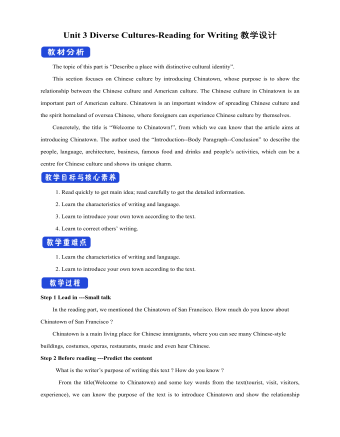
新人教版高中英语必修3Unit 3 Diverse Cultures-Reading for Writing教学设计
The topic of this part is “Describe a place with distinctive cultural identity”.This section focuses on Chinese culture by introducing Chinatown, whose purpose is to show the relationship between the Chinese culture and American culture. The Chinese culture in Chinatown is an important part of American culture. Chinatown is an important window of spreading Chinese culture and the spirit homeland of oversea Chinese, where foreigners can experience Chinese culture by themselves.Concretely, the title is “Welcome to Chinatown!”, from which we can know that the article aims at introducing Chinatown. The author used the “Introduction--Body Paragraph--Conclusion” to describe the people, language, architecture, business, famous food and drinks and people’s activities, which can be a centre for Chinese culture and shows its unique charm.1. Read quickly to get main idea; read carefully to get the detailed information.2. Learn the characteristics of writing and language.3. Learn to introduce your own town according to the text.4. Learn to correct others’ writing.1. Learn the characteristics of writing and language.2. Learn to introduce your own town according to the text.Step 1 Lead in ---Small talkIn the reading part, we mentioned the Chinatown of San Francisco. How much do you know about Chinatown of San Francisco ?Chinatown is a main living place for Chinese immigrants, where you can see many Chinese-style buildings, costumes, operas, restaurants, music and even hear Chinese.Step 2 Before reading ---Predict the contentWhat is the writer’s purpose of writing this text ? How do you know ?From the title(Welcome to Chinatown) and some key words from the text(tourist, visit, visitors, experience), we can know the purpose of the text is to introduce Chinatown and show the relationship between Chinese culture and American culture.
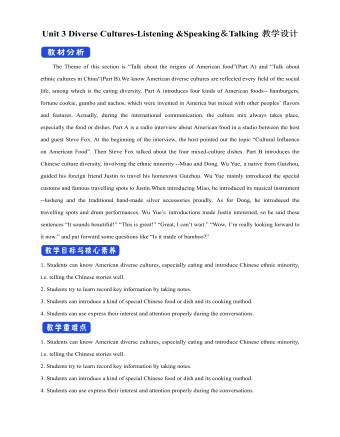
新人教版高中英语必修3Unit 3 Diverse Cultures-Listening &Speaking&Talking教学设计
1. In Picture 1 and Picture 2, where do you think they are from? How do you know?From their wearings, we can know they are from ethnic minority of China--- Miao and Dong.Picture 1, they are playing their traditional instrument lusheng in their traditional costumes.Picture 2. the girls are Miao because they wear their traditional costumes and silver accessory.2. In Picture 3, can you find which village it is? What time is it in the picture?It is Dong village. It is at night. Step 2 While-listeningJustin met a new friend while traveling in Guizhou. Listen to their conversation and complete the summaries below.Part 1Justin and Wu Yue watched some Miao people play the lusheng. The instrument has a history of over 3,000 years and it is even mentioned in the oldest collection of Chinese poetry. Then they watched the lusheng dance. Justin wanted to buy some hand-made silver/traditional accessories as souvenirs. He was told that the price will depend on the percentage of silver. Part 2They will go to a pretty Dong minority village called Zhaoxing. they will see the drum towers and the wind and rain bridges. They may also see a performance of the Grand Song of the Dong people.Step 3 Post-listening---TalkingWork in groups. Imagine Justin is telling some friends about his trip to Guizhou. One of you is Justin and the rest of you are his friends. Ask Justin questions about his trip and experience. The following expressions may help you.
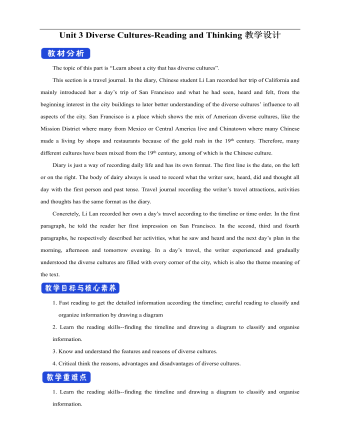
新人教版高中英语必修3Unit 3 Diverse Cultures-Reading and Thinking教学设计
Discuss these questions in groups.Q1: Have you ever been to a place that has a diverse culture ? What do you think about the culture diversity ?One culturally diverse place that I have been to is Harbin, the capital city of Heilongjiang Province. I went there last year with my family to see the Ice and Snow Festival, and I was amazed at how the culture as different to most other Chinese cities. There is a big Russian influence there, with beautiful Russian architecture and lots of interesting restaurants. I learnt that Harbin is called “the Oriental Moscow” and that many Russians settled there to help build the railway over 100 years ago.Q2: What are the benefits and challenges of cultural diversity ?The benefits: People are able to experience a wide variety of cultures, making their lives more interesting, and it can deepen the feelings for our national culture, it is also helpful for us to learn about other outstanding culture, which helps improve the ability to respect others. The challenges: People may have trouble communicating or understanding each other, and it may lead to disappearance of some civilizations and even make some people think “The western moon is rounder than his own.”Step 7 Post reading---RetellComplete the passage according to the text.Today, I arrived back in San Francisco, and it feels good (1) _____(be) back in the city again. The city succeeded in (2)_________ (rebuild) itself after the earthquake that (3)________ (occur) in 1906, and I stayed in the Mission District, enjoying some delicious noodles mixed with cultures. In the afternoon, I headed to a local museum (4)____ showed the historical changes in California. During the gold rush, many Chinese arrived, and some opened up shops and restaurants in Chinatown to earn a (5)_____ (live). Many others worked on (6)______ (farm), joined the gold rush, or went to build the railway that connected California to the east. The museum showed us (7)____ America was built by immigrants from (8)________ (difference) countries and cultures. In the evening, I went to Chinatown, and ate in a Cantonese restaurant that served food on (9)________(beauty) china plates. Tomorrow evening, I’m going to (10)__ jazz bar in the Richmond District. 答案:1. to be 2. rebuilding 3. occurred 4. that 5.living6. farms 7.how 8. different 9. beautiful 10. a
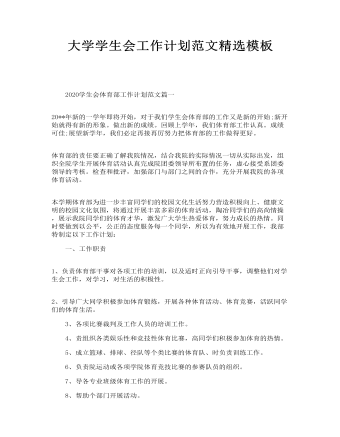
大学学生会工作计划范文精选模板
1、负责体育部干事对各项工作的培训,以及适时正向引导干事,调整他们对学生会工作,对学习,对生活的积极性。 2、引导广大同学积极参加体育锻炼,开展各种体育活动、体育竞赛,活跃同学们的体育生活。 3、各项比赛裁判及工作人员的培训工作。 4、责组织各类娱乐性和竞技性体育比赛,高同学们积极参加体育的热情。
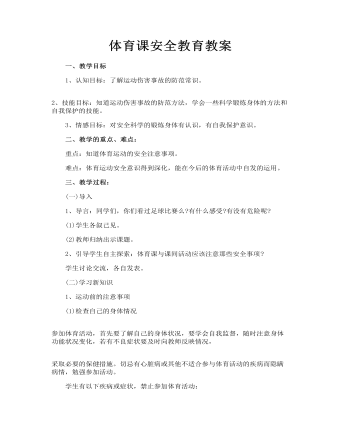
体育课安全教育教案
(一)导入 1、导言:同学们,你们看过足球比赛么?有什么感受?有没有危险呢? (1)学生各叙己见。 (2)教师归纳出示课题。 2、引导学生自主探索:体育课与课间活动应该注意那些安全事项? 学生讨论交流,各自发表。 (二)学习新知识 1、运动前的注意事项 (1)检查自己的身体情况 参加体育活动,首先要了解自己的身体状况,要学会自我监督,随时注意身体功能状况变化,若有不良症状要及时向教师反映情况, 采取必要的保健措施。切忌有心脏病或其他不适合参与体育活动的疾病而隐瞒病情,勉强参加活动。
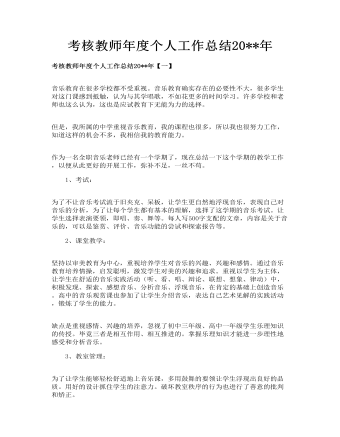
考核教师年度个人工作总结
1、考试: 为了不让音乐考试流于旧夹克、呆板,让学生更自然地浮现音乐,表现自己对音乐的分析,为了让每个学生都有基本的理解,选择了这学期的音乐考试。让学生选择表演要领,即唱、奏、舞等。每人写500字支配的文章,内容是关于音乐的,可以是鉴赏、评价、音乐功能的尝试和探索报告等。 2、课堂教学: 坚持以审美教育为中心,重视培养学生对音乐的兴趣、兴趣和感情。通过音乐教育培养情操,启发聪明,激发学生对美的兴趣和追求。重视以学生为主体,让学生在舒适的音乐实践活动(听、看、唱、辩论、联想、想象、律动)中,积极发现、探索、感想音乐、分析音乐、浮现音乐,在肯定的基础上创造音乐。高中的音乐观赏课也参加了让学生介绍音乐,表达自己艺术见解的实践活动,锻炼了学生的能力。 缺点是重视感情、兴趣的培养,忽视了初中三年级、高中一年级学生乐理知识的传授。毕竟三者是相互作用、相互推进的。掌握乐理知识才能进一步理性地感受和分析音乐。

人教版高中语文必修3《杜甫诗三首 秋兴八首》教案2篇
4、主旨 哪一联明确地点明全诗题旨?表达了作者的什么感情?试做分析 颈联。 菊花开在秋天,所以这 “ 丛菊 ” 回应了诗题中那个 “ 秋 ” 字。 “ 他日 ” 可以指过去也可以指未来,在这里是指过去。“丛菊两开”,指诗人于 765 年离开成都,原打算很快出峡,但这年留居云安,次年又留居夔州,见到丛菊开了两次,还未出峡,故对菊掉泪。秋菊两度盛开,使诗人再次洒下往日流过的眼泪。“开”字双关,一谓菊花开,又言泪眼随之开。此时他仍然滞留在他乡,他始终没有放弃回乡的打算。孤舟可以系住,使其不能泛诸中流,但诗人的心是系不住的。他的心早已越过江河,越过关山,飞到了长安。所以,一叶靠岸系绳的孤舟,始终都牵动着诗人的故园之思。这一联是全篇诗意所在。孤舟本来只能系住自己的行踪,却把诗人的思乡之心也牢牢地系住了,故见舟伤心,引出故园之思,表现出思乡之情的深沉浓烈和欲归不得的无奈与凄伤,为文章的主旨句。

人教版新目标初中英语七年级下册What does he look like教案3篇
所需要用到的句子:Who is that?That is Jack. I like him.Why do you like him?I like him because he is interesting.Task 4: 设计理想中的人类Step one: 设计理想中的人类的外貌。把全班同学分成若干小组,学生可以边说边在纸上画出他们的模样。Step two: 设计理想中人类的性格。学生们可以把那些能描述性格的单词写在图画的旁边。Step three: 每组选出一名同学,其他同组同学提问,他作简单回答,并说明原因。所需用到的句子:What does he or she look like?He or she ...What is he or she like?He or she is ...Why?Because ...Task 5: 挑战性活动调查性格是天生的还是后天形成的,让每个同学回家去调查一下自己成长过程中性格是否有变化,具体是怎样的,为什么会这样? Teaching Aims:1. Enable students to have a general understanding of how to talk about people's physical appearance.2. Enable students to tackle some essential vocabularies and patterns about describing people. Provide them with necessary skills and methods.3. Create various chances for students to describe the persons they're familiar with, such as classmates, family members, teachers, idols, etc.

人教版新目标初中英语八年级上册Can you come to my party教案3篇
Step 3 (3b)First, tell the students when we talk about our future plans, we often use: I’m+verb+ing When we talk about what we must do, we use have to. Ask the students to fill in the blanks in 3b. The answers are: shopping, go to see, a test, I’m going, my family. Step 4 (3c)Let the students write an e-mail message to a friend. Say why you can’t visit next. Before the exercise, ask the students to give some possible answers and write them on the blackboard. So the students will feel easy to finish the writing exercise. After they finish it, Let them to correct it in groups first. Each group chooses theirs best one to read in front of the whole class. Step 5 ( planning a party )First read the conversation in the box together. Then ask the students to turn to page 88.Write down everything you have to do next week. Write in all the things you have to do . Ask the students to look at the list. Ask them “What day are you free?” This is when you can have your party. Step 6 (Self check 1 )Let the students to fill in the blanks with the words given. Change the forms of the words if possible. Then make their own sentences. The answers are: visit, playing, have to, study, comeStep 7 (Self check 2)Imagine you are Marie. Read the information and look at your schedule. Write replies to the invitation.

人教版新目标初中英语八年级上册Could you please clean your room教案3篇
一、 教学内容Section A 1a----1c二、 教学目标1.学习词汇do the dishes, make the bed, take out the trash, fold the clothes, do the laundry, sweep the floor, clean the living room.2.句型 Could you please clean your room? Yes, sure.三、 教学准备 学生预习本单元所有的词汇多媒体课件 活动表 奖品四、 教学过程Pre-task1. Warming upEnjoy ourselves. Watch cartoon Cinderella. 看动画片段《灰姑娘》导如入本课话题和新词汇“chores”美丽善良的鬼姑娘因继母的嫉妒,每天得做所有的家务。片段的主题使学生联想到本课的话题。2. learn new words and phrasesLook! What is she / he dong? 看图学习动词词组do chores, do the dishes, make the bed, take out the trash, fold the clothes, do the laundry, clean the living room.3. Guessing game.What is she doing ? 4. Pair work. 1a, Do you do these things at home? Write “Y” for “yes” and “N” for “no”.5. Listening . 1b , Peter’s chores or Mom’s chores?理解目标语Could you please clean your room? Yes, sure.Write “M” for Mom’s chores, “P” for Peter’s chores in the chart.6. PairworkLook at the picture,Ask your partner to do the chores that you see. 7. Interview Who is the most able at home? 1) What chores do you do at home? How often do you do the chores? Work in four, interview each of the students in the group, fill in the chart.

人教版新目标初中英语八年级上册I’m going to be a basketball player教案3篇
教学目标1.知识目标:(1)学习What are you going to be when you grow up?/How are you going to do that?句式。(2)学会用英语描述有关职业的表达法。2.能力目标:(1)能够谈论为实现理想所做出的打算和安排。(2)能够谈论未来自己与他人理想的职业及原因。(3)能用英语描述课余时间的活动安排,最终具备表达综合信息的能力。3.情感目标:新学期到来之际,让他们在学习、体育、饮食、特长、读书等方面制定计划,教育学生合理安排自己的课外生活,思考自己的理想职业及适合自己的职业。教学重点、难点本单元的重点为“be going to”表将来,want to be, what,where, when,how引导的特殊疑问句。难点是语言目标的实现。教材分析本单元以I am going to be a basketball player为话题,共设计了三部分的内容:一、Section A该部分有4个模块。第一模块围绕Do you think these jobs are interesting?这一话题展开思维(1a)、听力(1b)、口语(1c)训练;

